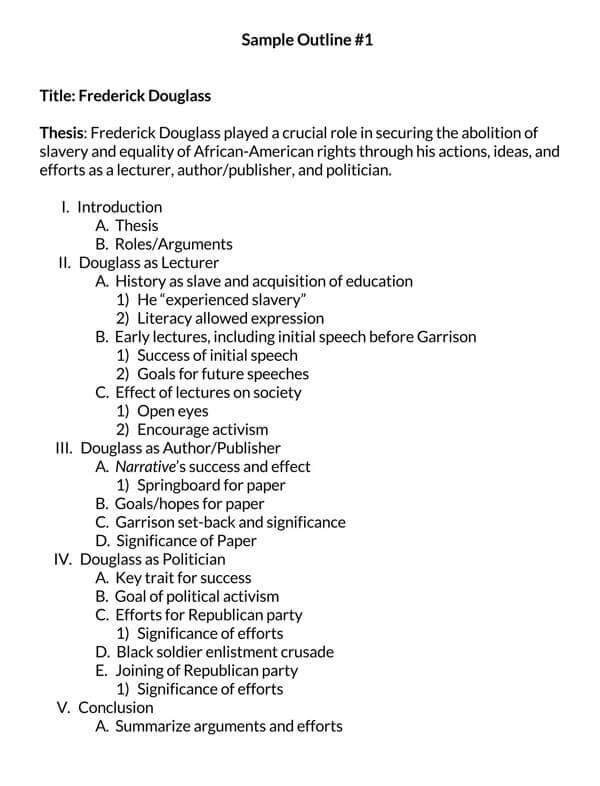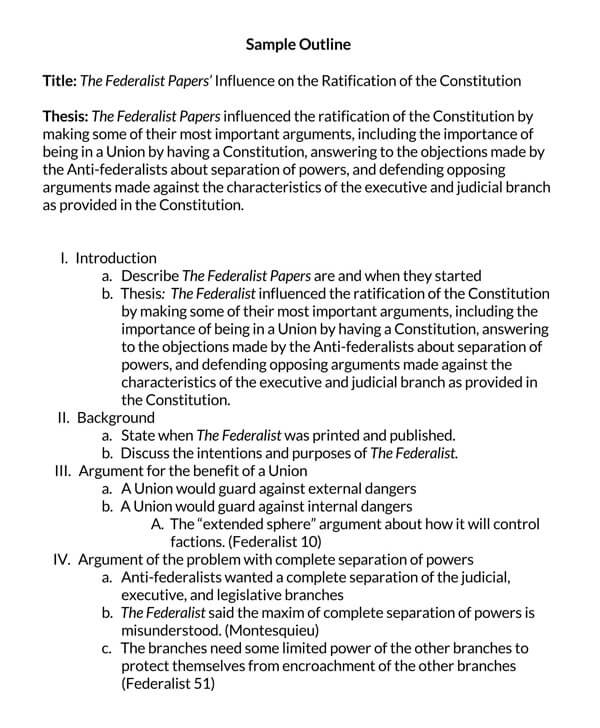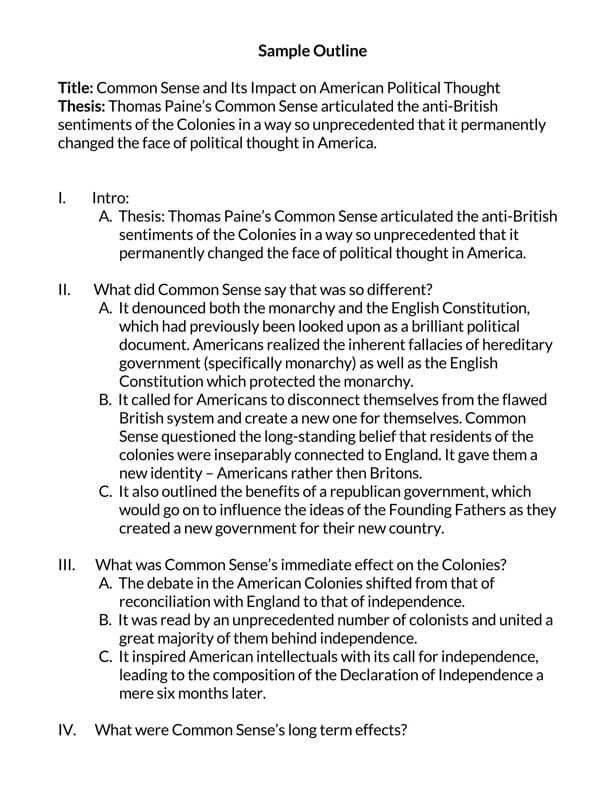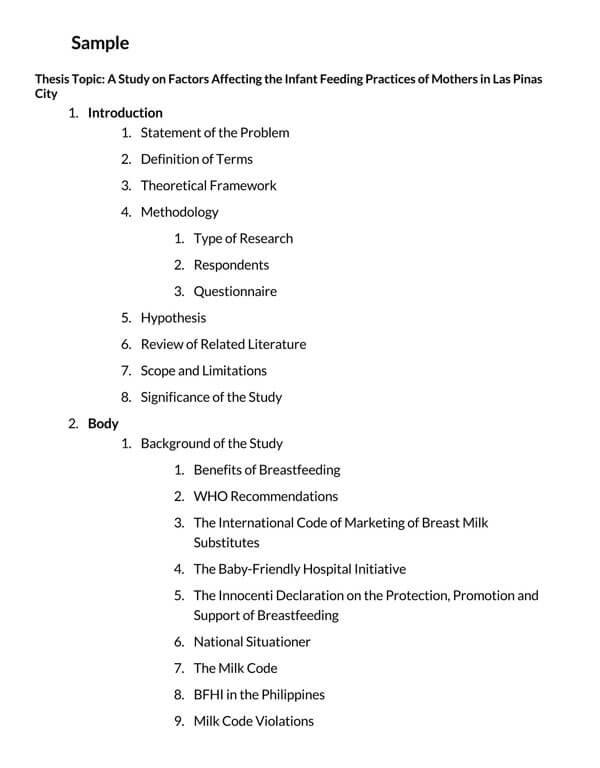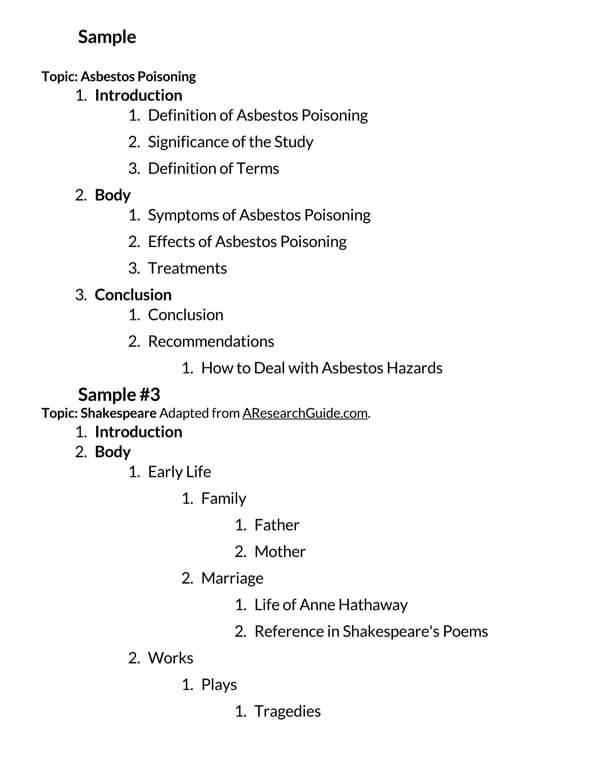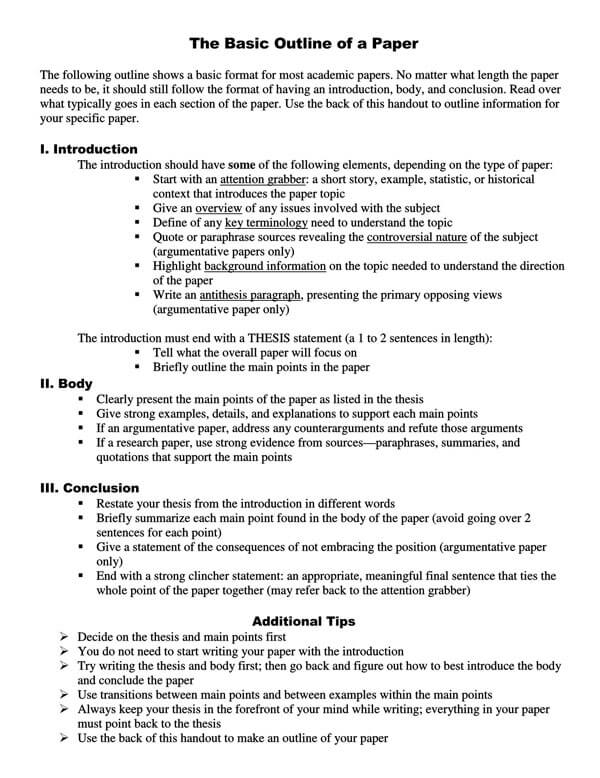A Research Paper Outline is a tool used by most writers to arrange ideas and information about a particular research paper or essay topic into a logical order.
It helps to provide the structure of the information that will be included in an essay or research paper. Whether it is a long or short paper, the best way for students to ease their writing process is by preparing a research paper outline.
Since a research paper outline acts as the skeleton of the main paper, students should learn how to write it. This can be achieved by writing down the topic and then highlighting the thesis and main ideas of the paper. As the student continues writing, an outline will help them gather new ideas and expand on the ones they already have.
Purpose of Research Paper Outline
A student who prepares a research paper outline before starting their writing process will benefit in different ways.
Here is a list of the purposes of having a research paper outline:
- A research paper outline provides all the key ideas that will be written in each paragraph. That means that a student using an outline is more likely to have sufficient information for their paper than a student who is not using an outline.
- A research paper outline helps students visualize how all the components of their paper will link together and form a coherent paper.
- An outline will guide and ease the work of a student who is writing a long essay or paper that does not follow the five-paragraph length standard.
- A research paper outline also offers a platform for students to organize their arguments that relate to the choice of a topic without forgetting or missing out on any.
Research Paper Outline Structure
There are different types of research paper types that different research paper outlines can be used for by students. The student should first establish the type of research paper they will write and then choose one of the research outline structures or types that fit their type of paper.
Some of these types include research outlines for descriptive essays, argumentative essays, and comparative essays.
The most common structure for a research paper outline usually consists of the main ideas of each of the paragraphs, a thesis, quotes, citations, topic sentences, and finally, the supporting sentences.
The structure usually sticks with the five-paragraph variation since most students’ essays are usually about the same length. A five-paragraph variation is usually made up of an introduction paragraph, at least 3 body paragraphs, and a conclusion paragraph.
A student usually prepares a research paper outline before tackling their essays if they have been requested by their institution. Most institutions also have their own research outline formats that the students must observe regardless of the given type of research paper or essay. Also, a student could have to follow the outline format as per their field and subject.
Note: At times, students are not asked to write a research paper outline by any form of authority. In such a situation, they can choose a format they like and suits their paper.
Style and Format of Research Paper Outlines
Students should learn and understand the language and format styles of their research paper outline. That way, they can know what is expected of them when they prepare their outline. Research paper outlines differ based on the format and language used.
The following are the details of the language and format of a research paper outline:
Format
There are three types of formats and writing styles that a student can use when creating their research paper outline.
These are:
Alphanumeric
Alphanumeric is the most common format of research outlines. It utilizes alphabetical letters, capitalized and lower case letters, Roman numerals, and Arabic numerals. If a student uses this format, the text should be in the form of short notes instead of long sentences.
For example:
1. (Title/heading of body paragraph-I): I. COVID-19
A. (First topic of the paragraph): Symptoms of COVID-19
1. (Sub-topic of the first topic): Tiredness
a. (Sub-topic of sub-topic): Aches and Pains
Full-sentence
This format is similar to the alphanumeric format. The only difference is that the text in this format is long sentences instead of short notes.
For example:
1. (Main topic body paragraph of the research paper): Understanding the origin of marijuana can help its legalization process
A. (First supporting fact/evidence to the main argument/topic): Marijuana was used in the past for medicinal purposes
1. (Sub-factor to the supporting evidence factor): The drug was used as a patent medicine in the 19th century
a. (Concluding sub-factor to the argument of the first supporting fact): It is used today to relieve symptoms and treat certain diseases
Decimal
For this format, the student should maintain the use of short notes instead of long sentences when writing their text. In most aspects, this format usually appears like the alphanumeric format, but the difference arises in the numbering system. The decimal format has a different numbering system to the alphanumeric system.
For example:
1. (Body paragraph of a topic): Symptoms of Pneumonia
1.1. (Supporting fact): Loss of appetite
1.1.1. (Supporting fact of point 1.1.): Shortness of breath
1.1.2. (Supporting sub-factor of point 1.1.): Treatments for Pneumonia
Language
A student should not ignore the language used when writing a research paper outline since it is equally essential to the format. Language is essential to observe, especially if the essay or paper will be handed to their teacher for grading.
Parallelism
For parallelism, the student should be consistent in their grammatical form within sentences.
This means that if the point in their heading has a verb, then the subheading should also have a verb, and if it is a noun in the topic, then a noun should be used in the subtopic. This repetition within a sentence is what is referred to as parallelism. It helps a student to maintain a consistent tone across their outline.
For example:
A. Highlight all the issues that are affecting people during this Covid-19 pandemic
1. Emphasize the economic issues affecting people
Coordination
For this part of the language being used in an outline, a student should focus on each point and ensure that they all have weight and importance. The subtopics should coordinate with each other and have the same value in the outline.
For example:
A. Explain the causes of Air Pollution in China
1. Include all the major areas affected by air pollution
B. Outline all the effects of Air Pollution in China
1. List and expound on what can be done to reverse these effects
Subordination
For this, the student should write their outline from a general angle to a specific one. That means that although the heading might be general, the student should build their subheadings and so on specific information.
For example:
V. MENTAL DISABILITY
A. Types of mental disability
1. Causes of mental disability
2. Symptoms of mental disability
Division
A student should ensure that each of their headings is divided into smaller sections. Although there is no limit to this kind of division, the student should have subheadings that match the number of paragraphs they intend to have in their essay or research paper.
The student should avoid having excess subsections as they will affect the flow of the paper during the writing process.
Guide to Writing a Research Paper Outline
Here is a step-by-step guide that a student can use to write a research paper outline before they dive into their writing process.
These steps are:
Determine the type of paper or essay
The first step is to establish the types of essay or paper that a student is about to write. Most high school research essays are usually either descriptive or argumentative. This means they usually maintain the five-paragraph variation. Therefore, the format of the research paper outline will not be challenging to use when preparing to write an essay
Select the type of topic
The next most important step is to choose the topic to be discussed in the final paper or essay. With a topic, the student can determine the headings and subheadings that they will need to address the topic and include all the information in the outline.
Professors usually select topics for their students. The best topics are arguable and interesting to the reader.
Research the topic
The student should then research the topic based on the headings and subheadings that have been included in the outline. Finally, they should gather notes based on their research on the topic.
Students can carry out their research online from different sources like journals, newspapers, books, websites, and even articles. They can also access different books and research papers from the school or other libraries.
Collect references and resources
After researching, the student should gather all the references and resources they used to research the topic. Collecting references and resources will be essential if they wish to add any more information in the outline before writing begins.
Carry out any research or investigation required
The student can also carry out more required investigations to ensure they have enough information for the topic and its subsections. This will also be the appropriate time to research and pick the proper research paper outline to write the essay.
Select the right outline structure
With the research paper outline selected, the student should now build the right structure. First, they should select the format and language to be used in the outline. For most essays, students are advised to the alphanumeric format and use parallelism when it comes to language.
The student should try and stick with the five-paragraph variation for their essay unless they are writing a very long research paper. That means the structure should have an introduction, body paragraphs, and conclusion. The body paragraphs should be structured in a way that they address the thesis.
Write introduction
The introduction paragraph in the outline should have ideas that attract readers and generate interest. They should build up the expected thesis and form the foundation of the upcoming subsections.
The introduction should also include the hook in the form of a question, anecdote, quote, suspense, or story as it helps to attract readers and gain their interest. The hook will also lead the readers to read the thesis statement, which is the main focus of the whole essay. Therefore, the hook should be an example or specific idea that introduces the topic and connects the readers to the thesis statement.
For example:
Humans have become so heavily reliant on technology that it forces us to ask the question, has the technology become bad?
Highlight thesis
The students should clearly highlight and elaborate on their research paper’s main ideas or thesis in the outline. This way, they will be able to generate ideas for the body paragraphs. The thesis should be the last sentence of the introduction paragraph and should be arguable.
The thesis statement is usually the final sentence of the introduction paragraph and usually contains three points.
For example:
There is a need to understand the dangers of society’s over-dependence on technology, especially social media, the internet, and gadgets like laptops, phones, and robots, for people to adopt safer technology use.
Body paragraph 1
The first body paragraph should highlight or build on the idea in the thesis. Then, it should have a topic sentence and other supporting sentences that help present a proper topic breakdown. Finally, the main point in the thesis should be well addressed in the paragraph.
For example:
People must understand that over-dependence on technology can result in health problems. Excessive use of the internet and devices like smartphones have been linked with mental health problems. Increased anxiety and depression cases have been associated with overdependence on technology. People become anxious when they cannot access the internet or find their gadgets. They fall into depression and lose interest when the activities they are involved in do not involve using technology. Such adverse effects result from over-dependence on technology and should encourage people to adopt better technology use.
Body paragraph 2
The second paragraph is similar to the first one in the terms that it should also have a topic and supporting sentence. This is because it should help address the thesis further and focus on building the essay research paper with concrete and correct information. In addition, it should have strong supporting arguments that back up the thesis, just like in body paragraph one.
For example:
Another danger of technology overdependence is a lack of skills. People need to reduce their technology use and adopt safer ways or risk unlearning and forgetting the necessary skills required in life, especially proper communication skills. With reference to social media, society has forgotten the essential communication skills and how to interact with each other without being behind a screen. People have become addicted to technology and lost touch with the people around them. Teenagers spend a lot of time on social media to the point that they lack the face-to-face communication skills necessary for things like an interview.
Body paragraph 3
The third body paragraph should also focus on expounding the thesis with the topic sentence and other supporting sentences. Including examples in this section of the outline will also help to make the final paper even better.
If it is an argumentative essay and the student presented ideas supporting the topic in the first two paragraphs, then this third paragraph would be a rebuttal. The example shown below is a rebuttal for the topic being addressed by the two body paragraphs above.
For example:
Nevertheless, many believe that technology is the future, and there is no over-dependence since technology improves every aspect of life. Research suggests that technology has brought about many benefits, and its usage cannot be tamed. Technological advancements, like ‘robots in the future,’ are bound to occur since technology is not being over-depended upon, but it is the new norm for society. More innovations due to technology are not bad; however, over-reliance is an issue that should be addressed. Technology cannot be limited, but its use can be controlled to avoid health problems and loss of basic skills.
Conclusion
The conclusion paragraph is the last section of the research paper outline. It should always begin by restating the thesis of the paper. The conclusion should tie the ideas together in the case of a descriptive essay.
For an argumentative essay, the conclusion should highlight where the student stands concerning the topic. Finally, the conclusion is where the student will have ideas about any suggestions that would be fit for future research.
For example:
Although there are many benefits of technology ranging from better health, education, and employment sectors, over-dependence will cause more harm than good to society. Trends in research show that people over-rely on technology for everything. Therefore, there is a need for change in the way people use technology. The adverse effects of over-reliance on technology will destroy the future instead of improving it as intended. With the knowledge of the dangers of over-dependence on technology, people can understand how important it is to embrace safe technology use. If these dangers of technology over-dependence are not taken seriously, society is bound to have a generation of lost persons.
Perfecting the Research Paper Outline
This information will help students create the best research paper outline, which will aid them effectively in completing a paper or essay.
To perfect a research paper outline, a student can use the following tips:
Organize your thoughts
As a student, using a research paper outline will only be successful if the information and thoughts are organized in levels. With proper levels, the student will be able to address the ideas meant for the essay or research paper.
Understand the flow and relation of information and ideas
The perfect research paper outline should also have a distinct correlation of ideas and how they flow. Main ideas should relate to the supporting ideas to ensure that the final paper also has a proper flow of information. It is also important that the student uses transition words to maintain the flow of the research paper.
Ensure nothing is forgotten
A research paper outline should include all the information needed in the research paper or essay being written. No information should be forgotten to ensure that the outline and the final paper make sense.
Be consistent
Every heading and subheading in the research paper outline should have a consistent tone. This means that the student should either indicate the topic or write a short sentence in the place of heading but not both.
Build support
A research paper outline should clearly discuss the main ideas in the actual paper or essay. However, an influential research paper should also build support by including all the supporting ideas. With enough information to support the main idea, the student has enough research for their essay.
Research Paper Outline Examples
Since having a research paper outline is an essential aspect of the writing process, students can use the examples to get a clear picture of what they need to prepare before handling their papers or essays. The research paper outline examples will also provide students with the correct breakdown of different research papers.
This is because the student can access research paper outline examples for different topics. As a student, the best way is to modify these examples to suit the paper to be written or choose to use the examples to prepare your own.
Students can access and download these research paper outline examples below. Find the outline example you need from our website today, download it, and create the best research paper outline for your papers and essays.
Following are some free downloadable research paper outline templates for you:
Frequently Asked Questions
What are the best tips for writing a Research paper outline?
There are three best tips that a student should observe when writing a research paper outline. A student should maintain a consistent tone across each heading, have a proper organization of paragraphs and support each topic with at least two supporting ideas.
Is the Research Paper Outline for a more extended essay the same as a shorter one?
A research paper outline for more extended essays tends to be a little bit different from shorter ones. While a shorter one observes the five-paragraph length, more extended essays may be different as they require the inclusion of more paragraphs in the outline. This means that a student will require an advanced organizer when dealing with more extended essays so as to fit all headings and subheadings.
For instance, when writing a thesis, a longer essay may require multiple paragraphs to explain its ideas, which makes it different from shorter ones that may require only one paragraph. Hence, these two types of essays will not have the same research paper outline.
What should be a research outline structure for compare and contrast essay?
A research paper outline for a compare and contrast essay is different as it includes an introduction, a paragraph with similarities, a paragraph with differences, and the conclusion.
What are the next steps after completing a research paper outline?
After completing a research paper outline, here are the next steps a student should follow. First, the student should keep a record of references which will help them avoid plagiarism in their work. Second, they should follow their learning institution’s guidelines when writing with references and footnotes or endnotes.
The student should also prepare their bibliography, which will be at the end of the research paper and on its own page. They should have a title for their essay. However, a student should keep in mind that the topic might change as they continue writing their paper.
The student should then start writing their research paper draft to further their research on the topic and subtopics in the outline. Their information should support their thesis or hypothesis.
The draft should be completed and formatted either using MLA 8 or APA 6th ed. format. The two formats are different when it comes to the bibliography page, in-text citations, line spacing, and title.
After that, the student should write their final paper. If they use APA, they should remember that this format requires a title page and an abstract. The abstract is used to briefly explain the information that has been written in the paper, the results of the research, and the conclusion.
